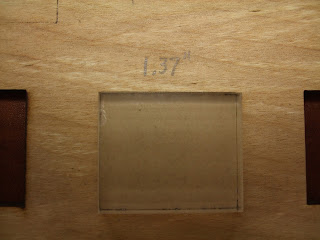Determination of Material Losses
An increase in power to 20% was required to get a cut through, even after adding more weights to keep the board flat and changing the laser frequency to 125 kHz. This was not expected because just two days ago with the same piece of wood on the same laser with the same cut speed I was able to cut through with only 15% power. This tells me that when you're on the threshold of not being able to cut through because you want to minimize the laser power, the conditions are very sensitive to differences in grain pattern, density and even possibly the level of the warping or unevenness of the board (even if you are just moving 9 inches down the board).
The inside edges of the frames were all wiped down with a terry cotton cloth to make a clean surface before inserting the cast Plexiglas standardized block.
Tests with inserting a 1.40 inch by 1.15 inch cast Plexiglass plain block reveal that about 0.02 to 0.03 of an inch is lost due to char and burn debris. This is for the horizontal (X) axis direction of the laser chamber coordinate system.
The losses in the vertical (Y) direction are somewhere between 0.01 and 0.02 inches.
While 20% power may not have been the minimum required to cut through the 3/16th inch wood, it was pretty close and was certainly not overpowering because inspection of the back side of the board revealed almost no burn spots on the nearby sections of board perpendicular to the edges of the cut.
My plan is to cut out a series of five blocks for each of the X and Y directions, this time changing the third decimal place in inches for the length of the cut.
You can see from the picture that the 10 blocks at a first glance all look to have the same dimensions, and yet the lengths are decreasing by 0.01 inches going from left to right as marked numerically in the photograph. Several zoomed in pictures show how the block falls through cleanly in several of the larger blocks on the left side, but only partially fall through or sit unevenly in a block which is too small to accommodate it. It was in this manner that I was able to narrow down to a range of losses of material due to the burn and char debris.
Left mouse click on any image to enlarge it in a new window
Note there is some wiggle room around this inserted block
this one a bit less
this does not truly insert
side view
Now the vertical (shorter in this case) length is varied
decreasing to 1.13 inches prevents a true insertion
at 1.12 inches it is obviously not going to insert at all









No comments:
Post a Comment